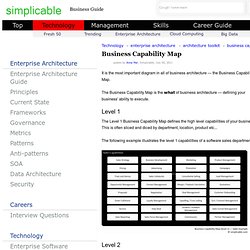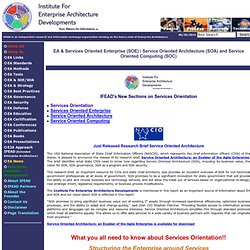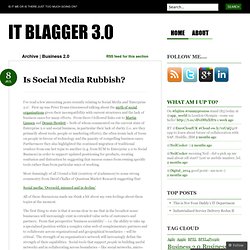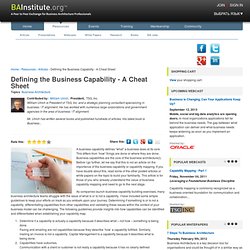

Business Capability Map. It is the most important diagram in all of business architecture — the Business Capability Map.

The Business Capability Map is the what of business architecture — defining your business' ability to execute. Level 1 The Level 1 Business Capability Map defines the high level capabilities of your business. This is often sliced and diced by department, location, product etc... The following example illustrates the level 1 capabilities of a software sales department: Level 2 The Level 2 Business Capability Map goes another level down in detail. Level 3. Description Enterprise Architecture Domain Reference. The Enterprising Architect. Enterprise Architecture & Services Oriented Enterprise / Service Oriented Architecture, Institute For Enterprise Architecture Developments (IFEAD) IFEAD's New Sections on Services Orientation What you all need to know about Services Orientation!!

Structuring the Enterprise around Services The Differences between Hype, Hope and Reality? "Things should be made as simple as possible, but not any simpler. " -- Albert Einstein By J. Download our SOA white paper here.... The terms Enterprise Architecture (EA), Services Oriented Enterprise (SOE), Service-Oriented Architecture (SOA) and Service Oriented Computing (SOC) are being exposed to an ever wider and more influential audience. This section is a preemptory effort to provide both a basic and somewhat advanced understanding of these terms: why they are important to us, where they come from and what this means for business & information technology (IT).
Frequently asked questions that revolve around this topic include: What is SPA? Enterprise Architecture in the Context of Services Orientation Enterprise Architecture Services Model Differences between hype, Hope and Reality. BCS - The Chartered Institute for IT. Business Architecture Guild - Home. IT Blagger 3.0. I’ve been terribly lax with my posting of late due to pressures of work but thought I had best try and put something up just to keep my blog (barely) alive, lol.

Following on from my previous posts on Cloud Computing and Service Delivery Platforms I thought I would go the extra step and actually talk about my views on Industrialisation in the platform and service delivery spaces. I made this grand decision since my last post included a reference to a presentation that I did in Redmond last year and so I thought it would be useful to actually tell the story as well as just punt up the slides (which can be pretty meaningless without a description). In addition there’s also been a huge amount of coverage of both cloud computing, platform as a service and industrialisation lately and so it seemed like revisiting the content of that particular presentation would be a good idea. The Industrialisation Imperative So why do I feel that IT industrialisation is so important? Accelerating Change.
Business Architecture (BA) Resources, Education and Training. Enterprise Capablity Modeling Framework. Abstract: The Enterprise Capability Modeling framework is a loosely defined methodology that exists to help IT professionals and/or their stakeholders define, develop, deliver, and understand, both, Enterprise Capabilities and Enterprise Capability Models (ECMs).

Such tools are used to help clearly identify, set strategy for, deliver, and support Enterprise Capabilities, as they pertain to the greater enterprise (i.e. the Enterprise Portfolio). This document will also help introduce the reader to the IF4IT Enterprise Capability Model (IF4IT ECM), which can be used as a reusable foundation for most Enterprise Capability Models, regardless of industry. Table of Contents IntroductionSome Basics About Capabilities and Capability ModelingUses and Benefits of an Enterprise Capability ModelCapabilities vs.
Introduction This document is intended to introduce the reader to two key concepts... Business Capabilities. In turbulent times, budget pressures increase and IT spending is scrutinized.

We will describe a technique that Microsoft architects around the world use every day to ensure that IT projects have both a clear alignment with the strategic goals of the organization and a strong demonstrable impact. This is used to prioritize the project portfolio to maximize return on investment (ROI) and determine the projects that should receive budget and resource allocation. Methods include Microsoft Services Business Architecture (MSBA) to identify what to change and the Benefits Dependency Network (BDN) to understand fully whythe changes must be made. This leads to a clear alignment withhow the projects will make those changes. BPM analysis, opinion and insight. Resources in Business Architecture. Defining the Business Capability - A Cheat Sheet. A business capability defines “what” a business does at its core.

This differs from “how” things are done or where they are done. Business capabilities are the core of the business architecture(i). Before I go further, let me say that this is not an article on the importance of the business capability or capability mapping. If you have doubts about this, read some of the other posted articles or white papers on the topic to build your familiarity. This article is for those of you who already understand the value of business capability mapping and need to go to the next stage. As companies launch business capability building exercises, many business architecture teams struggle with the issue of what is or is not a capability. Determine if a capability is actually a capability because it describes what – not how – something is being done. One last point here for those organizations just getting started.